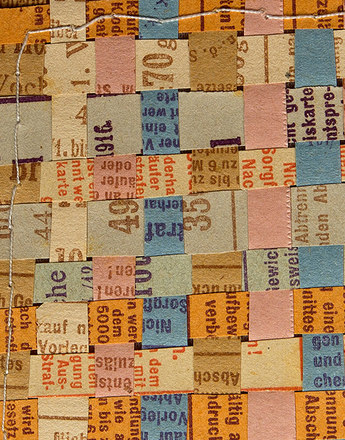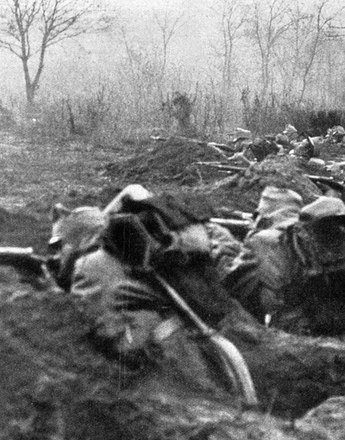-

Textile substitute made from paper cloth, sample from the A. Herzmansky department store (Vienna), 1917/18
Copyright: Technisches Museum Wien
Partner: Technisches Museum Wien -

Sample sheet of the paper thread cloth from the Henckel von Donnersmarck A.G. paper factory at Frantschach, Carinthia, 1917
Copyright: Technisches Museum Wien
Partner: Technisches Museum Wien
Within a very short time after the outbreak of war, uniforms had to be provided for entire armies. Domestic textile fibres were in short supply, however. Paper textiles made of wood pulp from domestic forests were thus used above all to supply the civilian population.
The war increased not only the demand for metals but also for clothing, as uniforms had to be found for hundreds of thousands of soldiers. Production of plant and animal fibres in the Habsburg monarchy had been declining, however. The cultivation of flax had dwindled since 1875 by around 40 per cent, and two thirds of the flax had to be imported. Since the 1850s the sheep population had also shrunk by a third, and wool was obtained from Argentina, Australia and other countries. Cotton was also imported from the USA and India.
Industry started by using blended fabrics and various types of synthetic wool obtained from old rags and spun clothing. The cultivation of hitherto rarely used textile fibres like nettles was encouraged. The processing of nettles into fabric in fact had something of a tradition, but it was not followed up in practice to any significant extent. The best substitute was paper textiles. The raw material, wood pulp, was abundantly available in domestic forests and could also be used for other purposes. Most companies made sulphite pulp, however, and few supplied the stronger and more robust soda pulp, which was better suited for the manufacture of paper for spinning. One company making this pulp was the gräflich Henckel von Donnersmarck’sche Papierfabrik AG in Frantschach, Carinthia. Because of the shortage of capacities, paper for spinning was imported at high price from Sweden and Norway. The increasing scarcity of textile fibres forced linen manufacturers and later makers of cotton and wool products to turn to paper yarn. The paper cutting machines came from Maschinenfabrik Jagenberg in Düsseldorf, Germany.
The manufacture of paper and blended paper textiles was something of a challenge. The marketing and distribution under wartime conditions was also anything but easy. Although paper yarn products were not new – they had been known in the Far East for centuries and were also used to a limited extent in Europe and the USA – they were not popular. They were difficult to wash and look after and people feared that they would disintegrate in the rain. In the last two years of the war, however, they were on sale in the large department stores in Vienna such as Herzmansky in Mariahilferstrasse. To encourage sales, clothes made of paper were put on display in 1918 at the surrogate exhibition in the Prater, with artistic contributions by members of the renowned Wiener Werkstätte. Most of these goods rapidly disappeared after the war, however.
Translation: Nick Somers
Bericht über die Industrie, den Handel und die Verkehrsverhältnisse in Niederösterreich während der Jahre 1914–1918. Dem Staatsamte für Handel und Gewerbe, Industrie und Bauten erstattet von der n.-ö. Handels- und Gewerbekammer in Wien, Wien 1920
Schmidt-Bachem, Heinz: Aus Papier. Eine Kultur- und Wirtschaftsgeschichte der Papier verarbeitenden Industrie in Deutschland, Berlin/Boston 2011
Schwarz, Richard: Die Spinnpapierindustrie, in: Katalog der Ersatzmittel-Ausstellung Wien 1918, hg. von der Ausstellungskommission, Wien 1918, XXV–XXXIII
-
Chapters
- Chicory, peat & Textilit: surrogates before the war
- The age of iron
- Bells for bullets: metal collection
- Fragile clothing: textiles and paper fabrics
- Well shod? Tanning agents and leather
- Rubber goods: elastic and essential
- From far and near: resins and resin products
- The 1918 surrogate exhibition in the Prater





